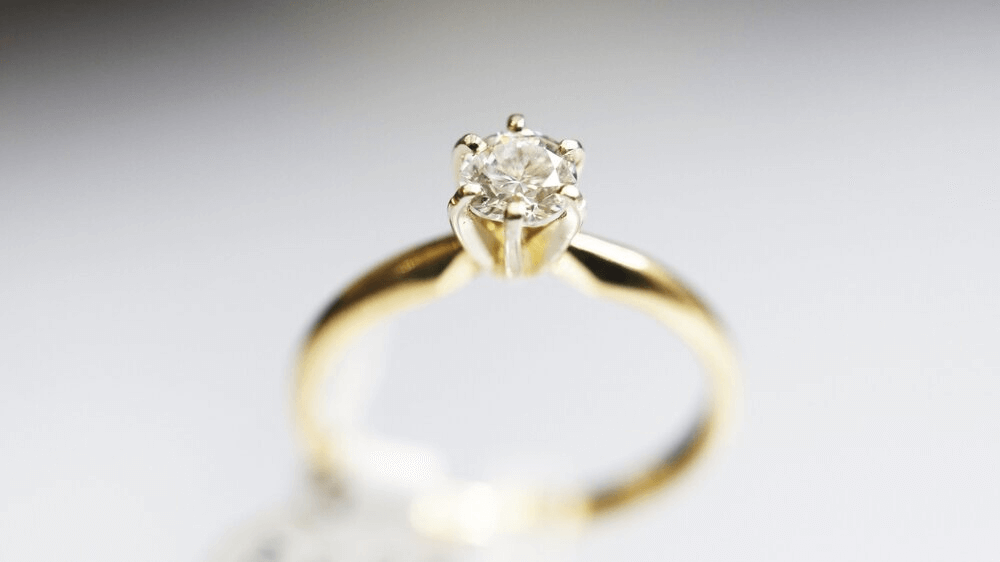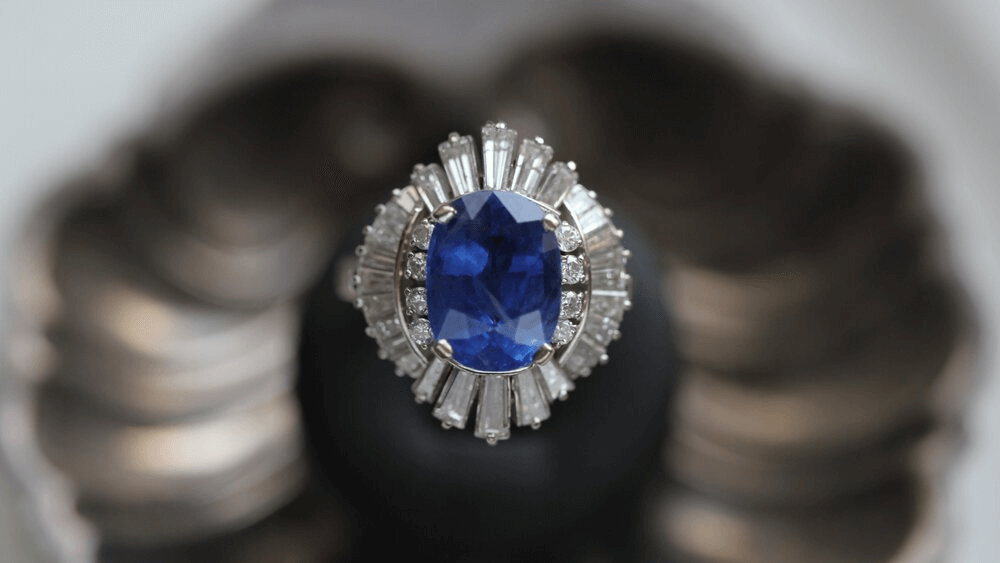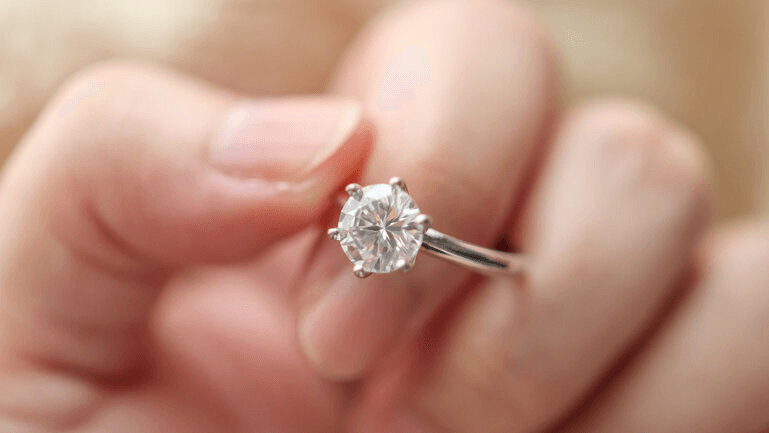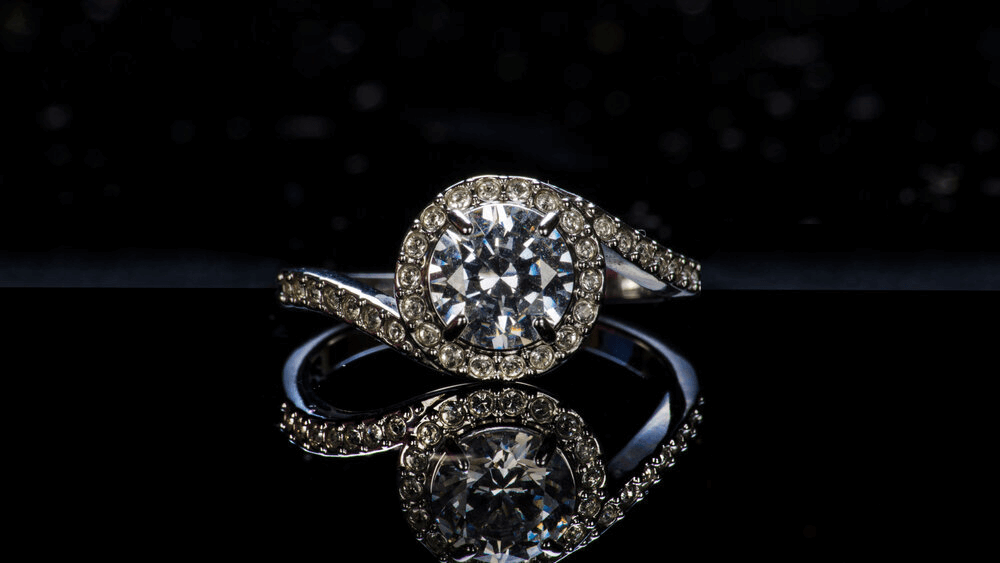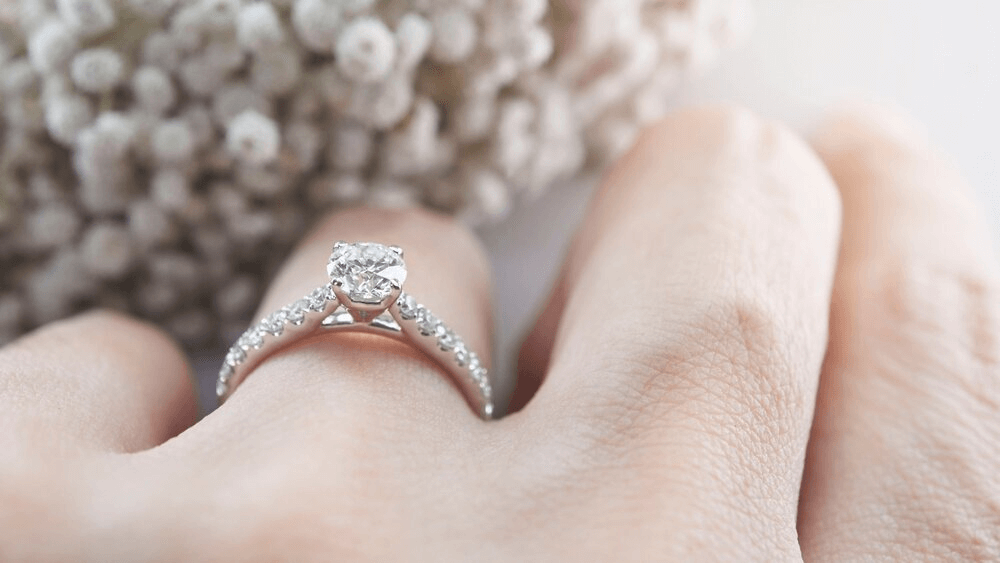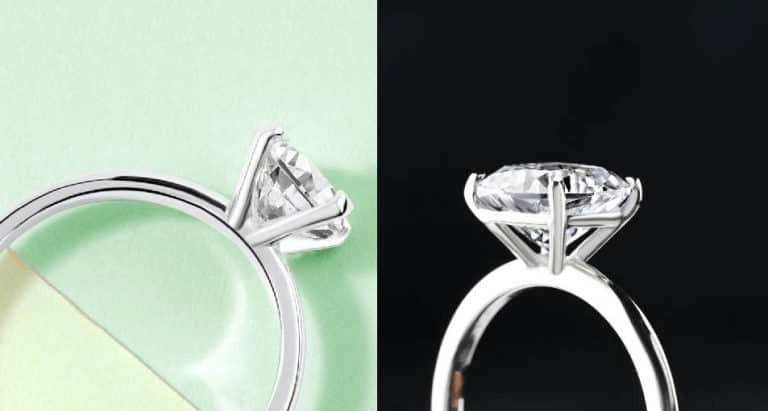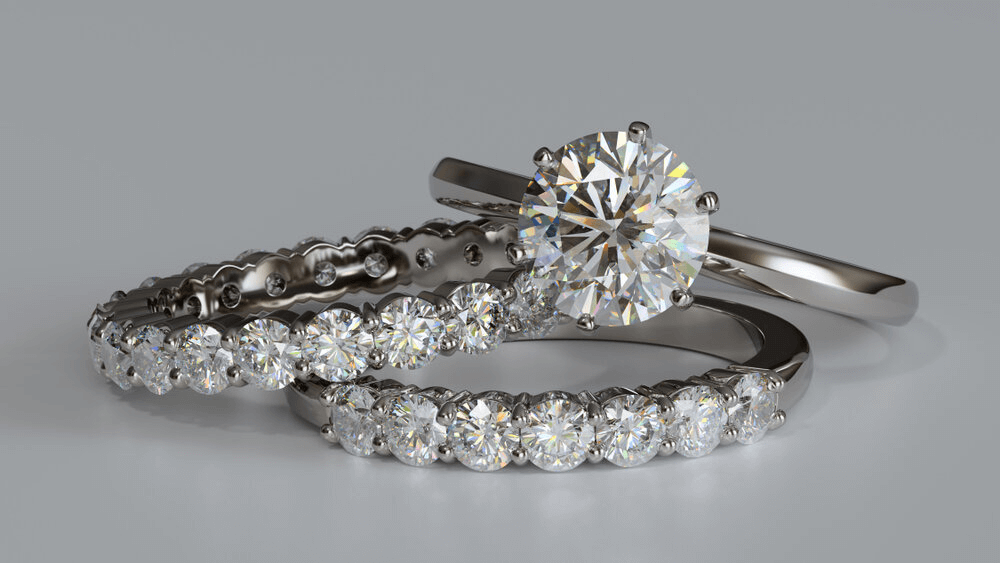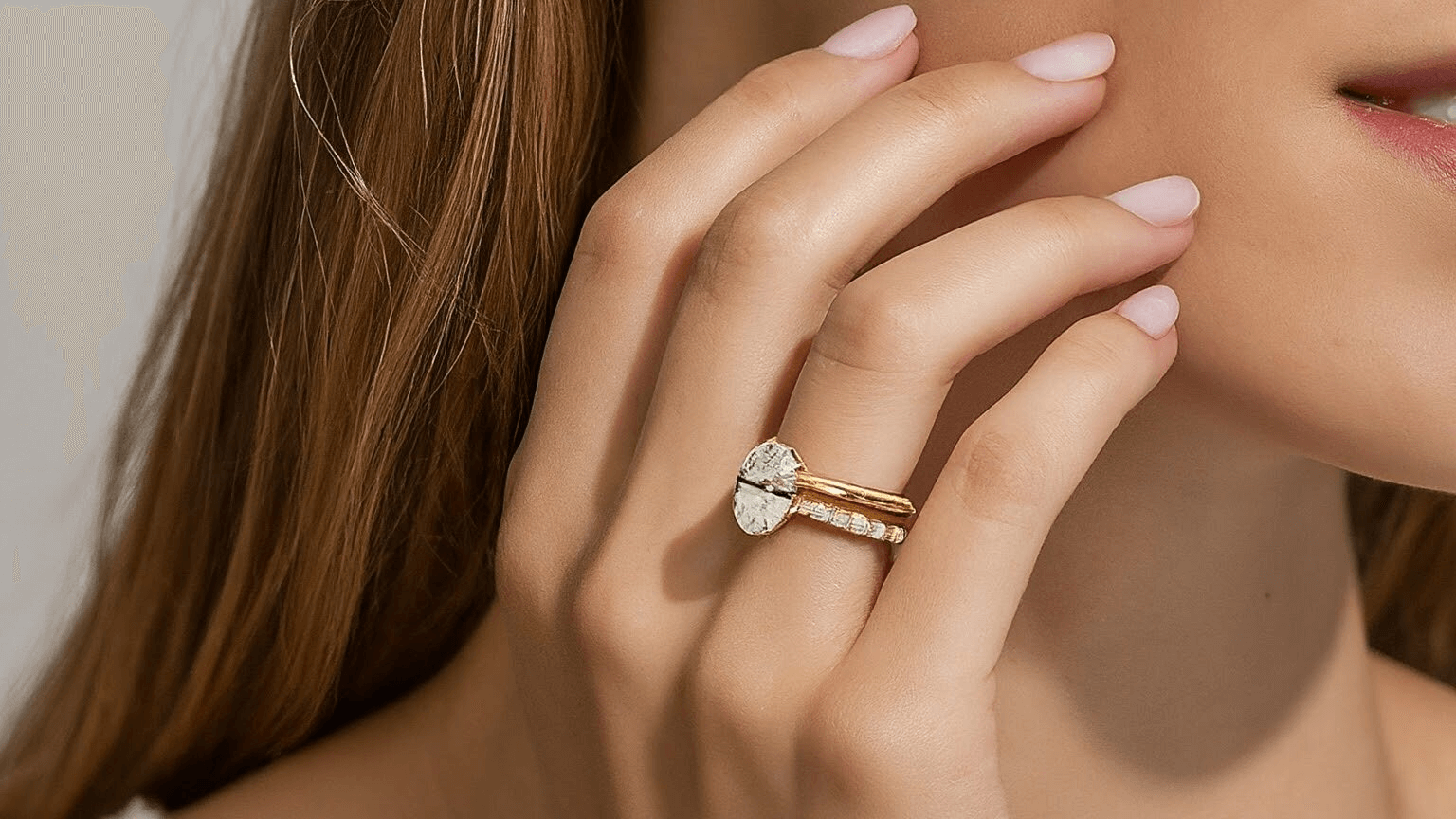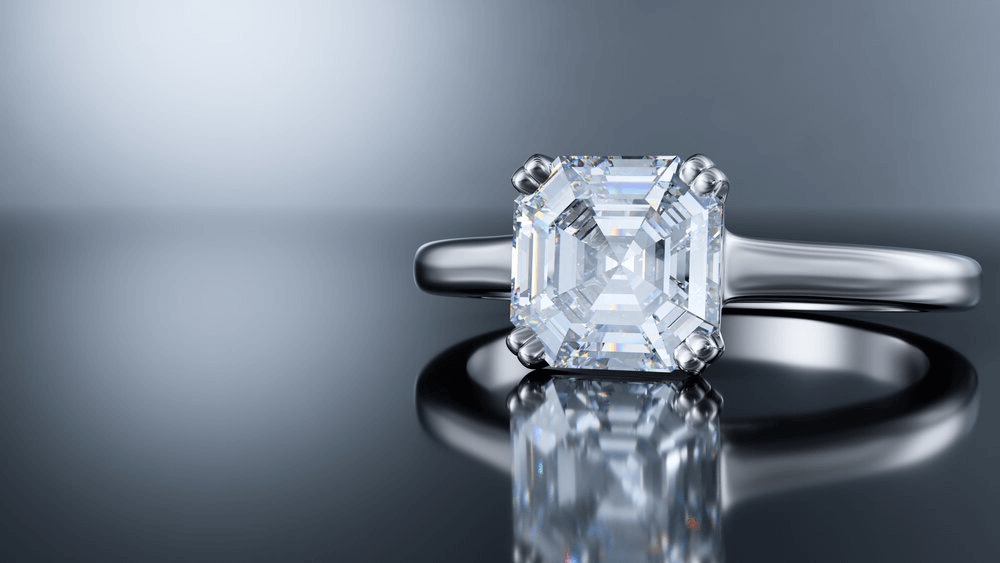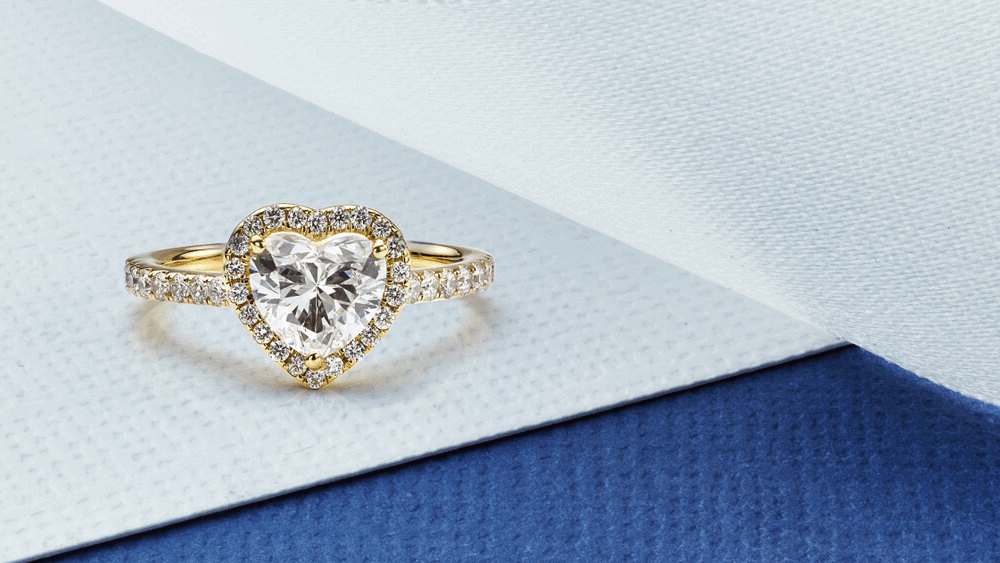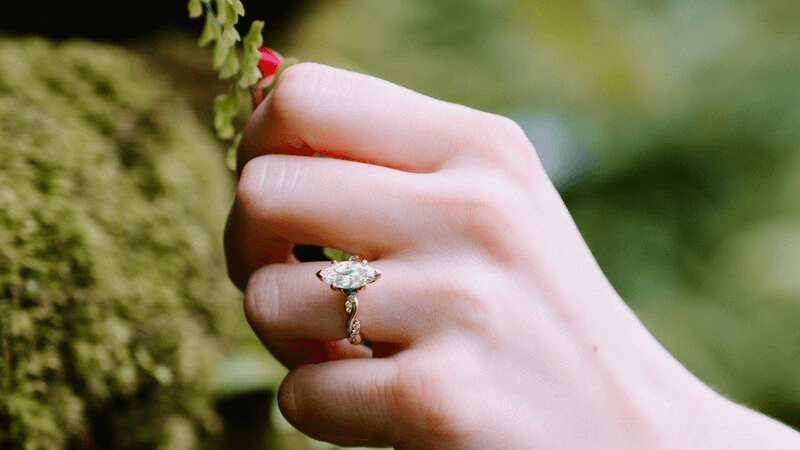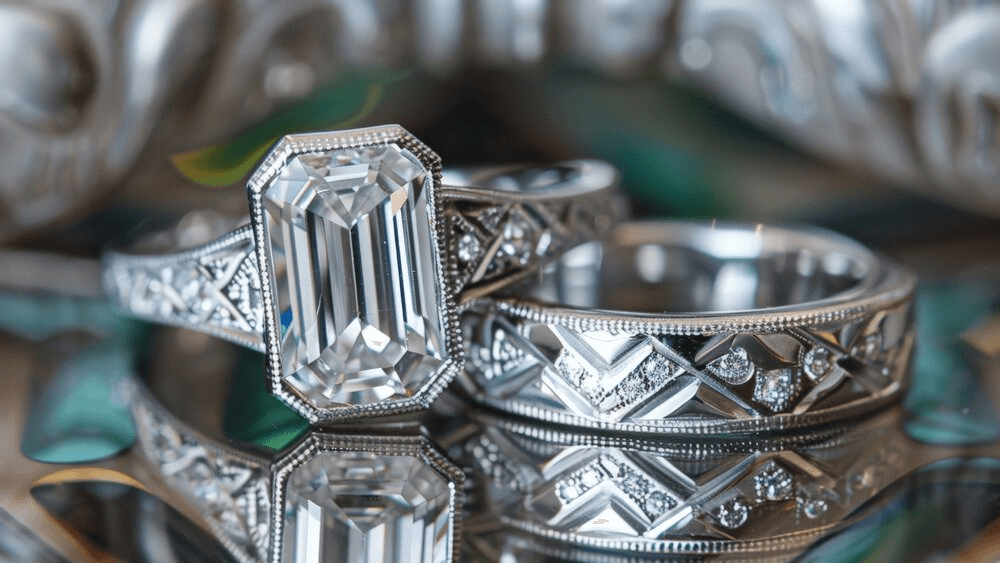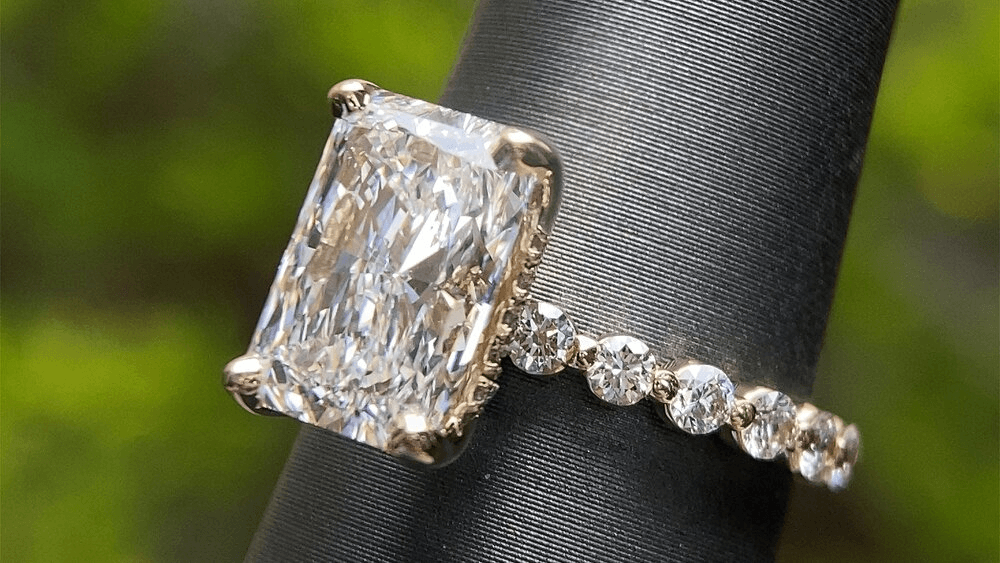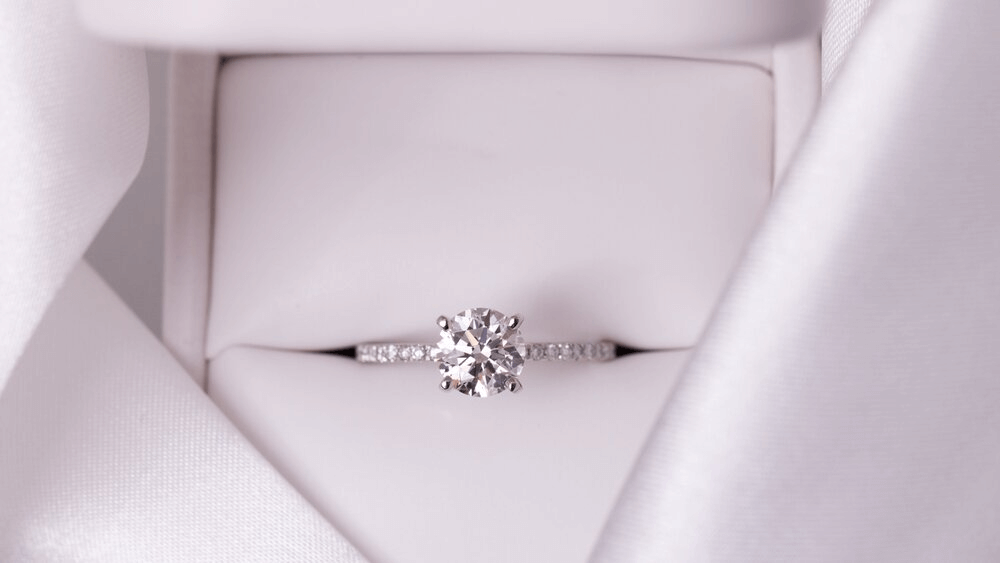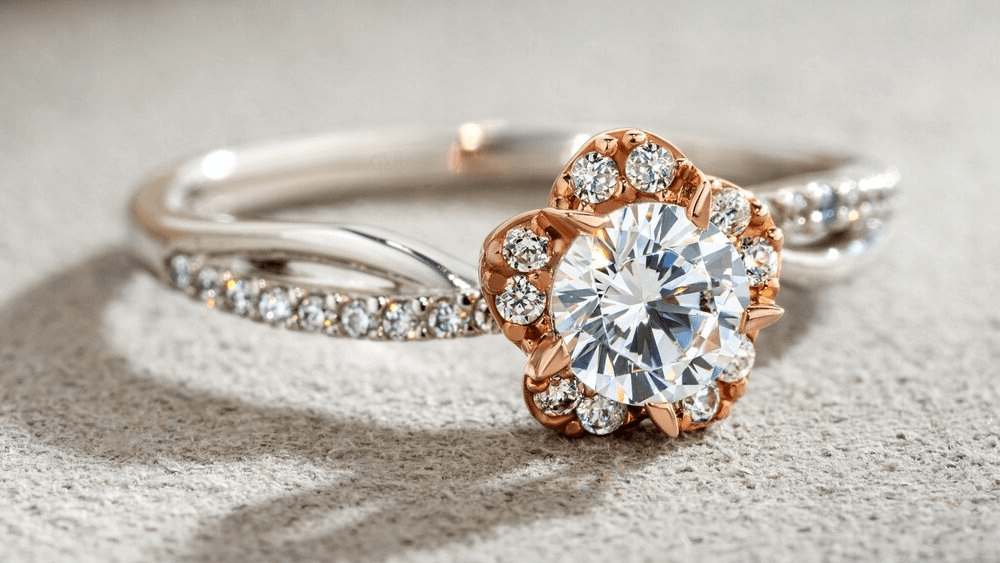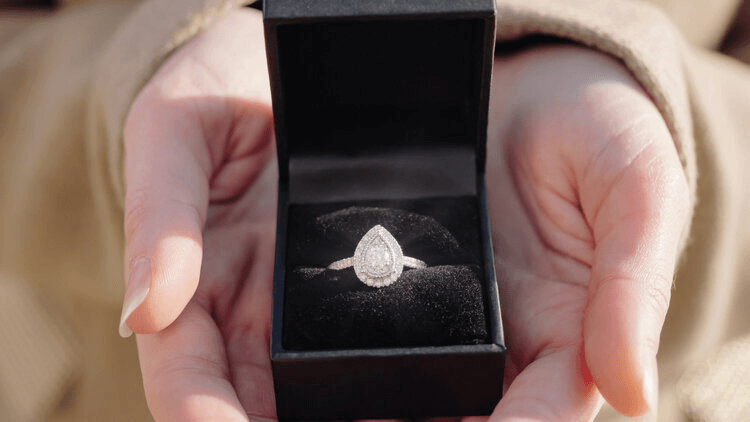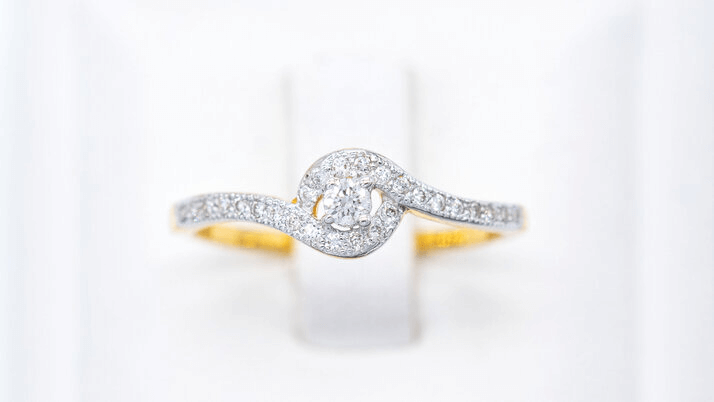The Ultimate Guide to Pavé Diamond Engagement Rings

By Gary A.

Edited by Olivia H.
Published Aug 17, 2021
Edited on Dec 23, 2024
Pavé diamonds add an irresistible sparkle to engagement rings, effortlessly enhancing the center stone’s brilliance without stealing the spotlight. Explore our complete guide to pavé settings and discover how to elevate your ring to the next level of elegance.

Navigate This Guide:
- 7 Quick Tips for Buying a Diamond Engagement Ring with a Pavé Setting
- Introduction to Pavé Diamonds
- Value and Worth of Pavé Diamonds
- Practical Considerations for Pavé Rings
- French Pavé vs Traditional Pavé
- Pavé Settings vs Channel Settings
- Pavé Settings and Diamond Shape
- Resizing a Pavé Diamond Ring
- Pavé Setting Versatility: Combining it with the Cathedral Setting
- Our Expert Take
- 10 FAQs
Before we dive deeper into the specifics, here are some practical tips to help guide your decision-making process:
7 Quick Tips for Buying a Diamond Engagement Ring with a Pavé Setting
Practical Tips for Buying a Diamond Engagement Ring with Pavé Settings When selecting a diamond engagement ring, particularly with pavé settings, there are several crucial aspects to consider to ensure you’re making an informed and satisfying purchase. Below are key tips, marked for clear differentiation:
- Tip 1: Assessing the Uniformity of Pavé Stones: Uniformity is Key: Ensure that the pavé diamonds in the setting are uniform in size and color. Mismatched pavé stones can detract from the ring’s overall beauty and may indicate lower craftsmanship quality.
- Tip 2: Checking for Durability and Secure Settings: Secure Settings: Examine the ring closely to ensure that the pavé diamonds are securely set. While pavé settings are known for their beauty, they can be susceptible to stone loss if not set properly. Look for small prongs or beads holding each stone firmly in place.
- Tip 3: Metal Choice and Pavé Impact: The choice of metal can significantly affect the appearance of pavé diamonds. Opt for metals like platinum or white gold to enhance the brilliance of pavé stones. These metals provide a strong and durable setting, crucial for the smaller pavé diamonds.
- Tip 4: Balance Between Center Stone and Pavé: Harmony in Design: Choose a pavé setting that complements, rather than competes with, the center stone. The pavé diamonds should accentuate the main diamond, adding sparkle and elegance without overpowering it.
- Tip 5: Considering Future Resizing Needs: Resizing Considerations: Remember that resizing a ring with a pavé setting can be challenging, especially if the diamonds encircle the entire band. Consider opting for a half-pavé design if you anticipate needing resizing in the future.
- Tip 6: Paying Attention to Pavé Patterns and Styles: Styles and Patterns: Familiarize yourself with different pavé styles, such as micro pavé, French pavé, or bright cut pavé. Each style offers a unique look and feel, so choose one that aligns with your personal taste and the wearer’s style.
- Tip 7: Easy Maintenance for Lasting Brilliance: Maintenance is Crucial: Understand that pavé diamond rings require careful maintenance to retain their sparkle. Regular cleaning and occasional professional inspections are recommended to keep the pavé diamonds in pristine condition.
Now that you’ve got these practical tips, use Jeweler AI below to find the perfect engagement ring that suits your style and budget:
Introduction to Pavé Diamonds
Creating the perfect ring is, above all else, a process of learning quite how many different factors go into the creation of a single diamond ring. While that center diamond is undoubtedly your primary concern when you’re starting to look at creating an engagement ring, it won’t be long before you have to start focusing on the rest of the ring, beyond that focal point.
More specifically, it won’t be long before you’ll be introduced to one of the most popular settings out there today: the pavé.
Beautiful, eye-capturing, and incredibly versatile, this technique is one that we would recommend all but the most minimalistic shoppers consider – and something you should keep at the front of your mind when you’re on our online store.
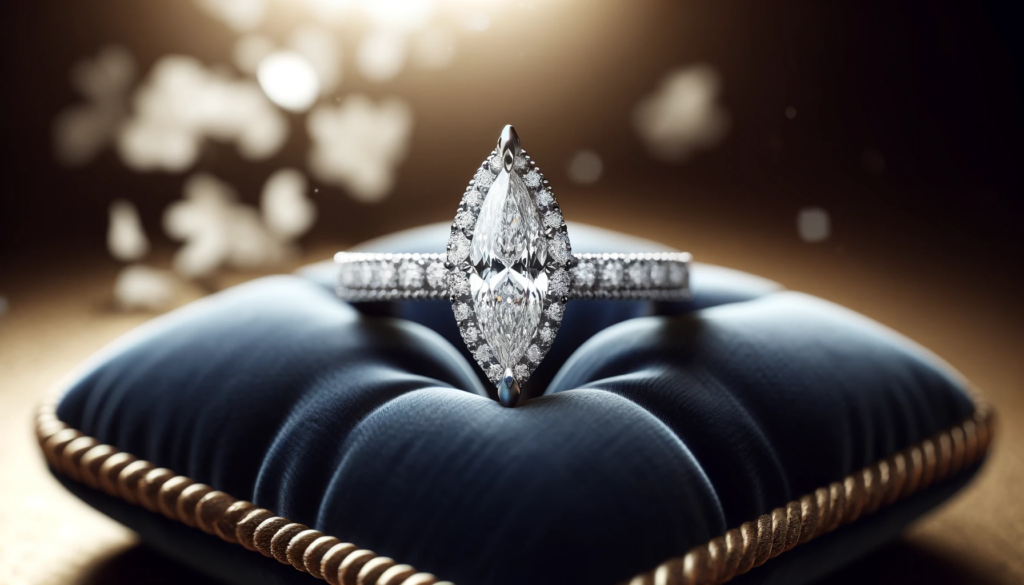
Definition and Characteristics
For the Pavé, many small diamonds are set closely alongside one another around the shank (band) of the ring.
The word pavé is French for ‘paving’ – pronounced pah-vey – as the jeweler quite literally paves the ring with these tiny, sparkling diamonds like stones along a sidewalk.
A pavé setting can be used the full length of the band, or halfway (leaving the palm-side of the band clear). Its popularity stems from the fact that it offers a great way to complement the center diamond – or diamonds – without risking overshadowing them.
Popularity in Engagement Rings
The extra sparkle can definitely play a little trick on the eye, and make the entire ring look more dominant on the hand. It won’t make a huge difference, but the results will be gorgeous, nonetheless.
The best part about a pavé setting is that it doesn’t encroach upon the diamond at all – it offers a beautiful complement to that center setting while remaining secondary to it.
Pavé diamonds sparkle in a very different way from large diamonds. Their much smaller surface area – and the fact that there are more of them – means that they seem to react to light like glitter, with a dazzling twinkle that rolls over the bridge of the finger with every hand movement and gesture.
A solitary center diamond of around one carat or more sparkles in the same way, but on a bigger scale. The effect is totally different and more mesmerizing – flashes of fire and brilliance, rather than a continuous, bright glimmer.
Together, the effect is truly entrancing – and a compelling reason to complement your diamond with a pavé setting.
Value and Worth of Pavé Diamonds
Pavé diamonds are almost always sold in bulk and for a price nowhere near as high as a larger, single diamond.
All diamonds have value, and melee diamonds will never be considered useless. The popularity of pavé, channel and halo settings means that there will always be a demand for these tiny offcuts, though, obviously, not the same level of demand that there is for beautiful center diamonds – particularly those above one carat in weight.
Consider the fact that, for every dazzling diamond atop someone’s engagement ring, there is at least a small handful of melee diamonds out there. These diamonds will have been added to a larger collection and sold to jewelers based on their total carat weight (TCW), rather than individually.
When you buy a pavé set ring, you might see the phrase ‘total carat weight’ used. This is simply an easier way of calculating the cost of many tiny diamonds. A total carat weight of, say, one will likely cost less than a one carat diamond of similar quality since larger diamonds are less common.
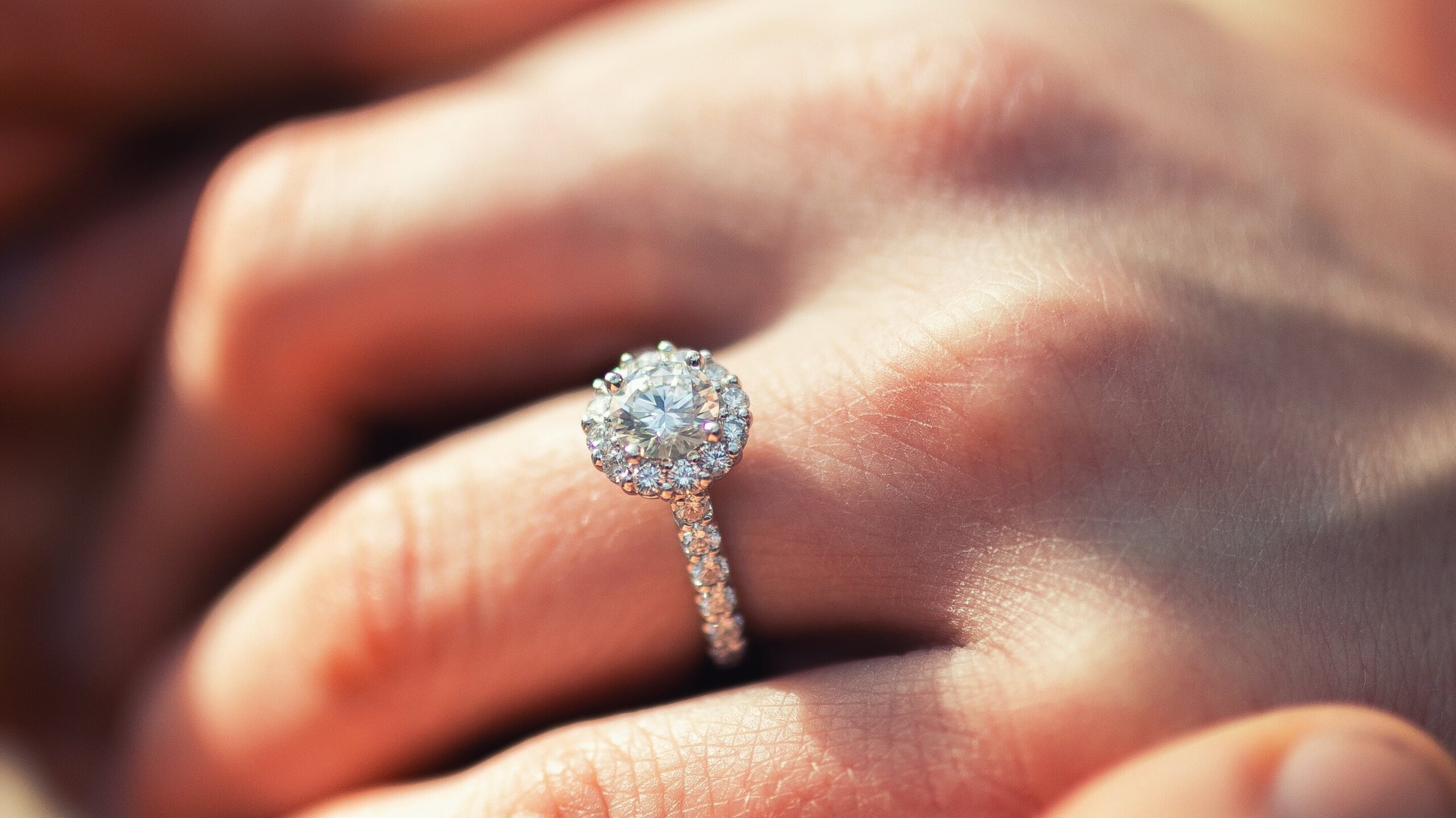
Factors Affecting Value
This depends on your source. Our diamonds at Will You are always properly sourced, and checked by a diamond expert, meaning they are not only real (as opposed to lab grown) but they are conflict free.
Since pavé diamonds are sold by the bag, it is all too easy for poor quality, artificial or unethically sourced stones to be added into the mix in order to raise the (supposed) TCW of the collection.
A number of retailers deal with thousands of orders, and, for some, individually checking each diamond that comes into their production line is absolutely impossible. Each business will have their own methods for sorting these diamonds, but at WillYou, we always hand-check, sort, and ensure the quality of every single one.
This not only gives you clarity over the quality, but also helps you feel safe and secure in your purchase. After all, it takes a true expert to look at a diamond so small and assess whether or not it’s up to standard, and with 45 years under their belt, our diamond expert has had plenty of time to master the skill.
Melee Diamonds Carat Weight
Generally around 0.01 to 0.02 carats in weight, or about 1.5 – 1.7mm in diameter if your pavé stones are round cut. Any larger, and the shank will need to be noticeably wider.
No diamond is pulled from the earth sparkling and perfectly faceted; it takes time and expertise to cut away the excess and craft the rough stone into a symmetrical and mesmerizing diamond. Pavé diamonds are created inadvertently during this cutting process, as small fragments that, with some shaping and polishing, emit their own beautiful sparkle.
In the US, they’re often referred to as ‘smalls’ or melee diamonds, provided they’re less than 0.2 carats in weight. But, believe it or not, melee diamonds can be much smaller than that. As a rare substance, no part of the diamond is wasted, provided it can still be turned into something beautiful. These minute stones, sometimes smaller than a millimeter in diameter, are used to create micro-pavé settings for skinny bands.
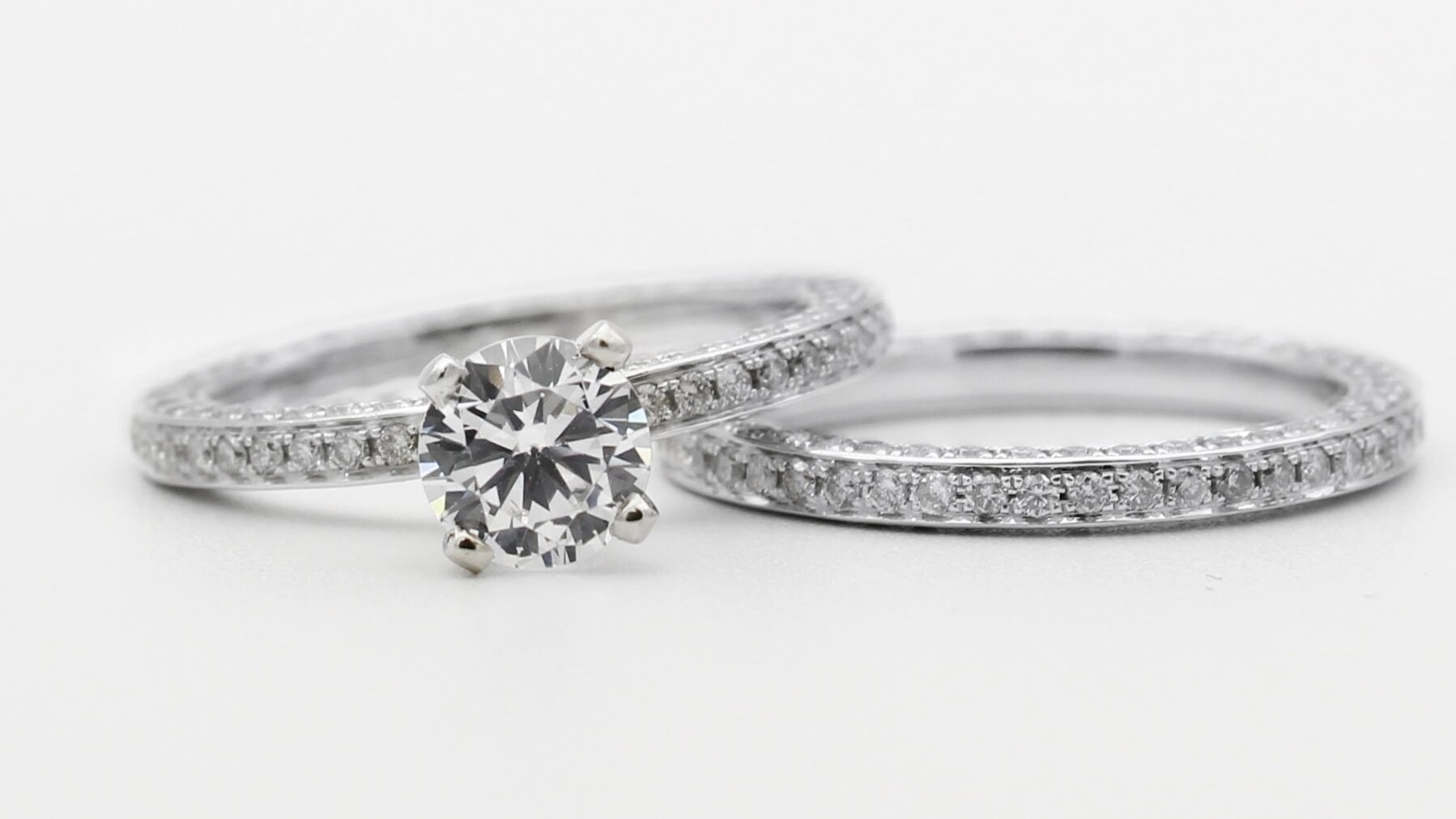
Practical Considerations for Pavé Rings
Durability and Security of Pavé Rings
Pavé involves setting the diamonds with prongs or tiny metal beads, which secure the diamonds in place without being too obvious.
From a distance, anyone could be forgiven for thinking that those pavé diamonds are somehow floating in the band and that the slightest knock could send them flying at all angles.
This is, of course, an illusion – and an example of how stealthy an expert jeweler can be when it comes to securing even the smallest of diamonds in their place. It’s not easy, but the idea is always to make it look as though they simply belong there, and as though the metalwork securing them in place is simply a part of the shank’s decoration.
It takes a great deal of detail, precision and patience, the results are definitely worth it in the end.
Do Pavé Diamonds Fall Out Easily?
So long as they’ve been set by an experienced jeweler, and the diamonds sourced from a quality supplier, they won’t end up falling out. Of course, it’s not impossible for any diamond to work itself loose from its setting over time but, with regular checkups – say, once or twice a year – and a gentle cleaning and maintenance routine, this is pretty unlikely to happen.
Comfort for Wearers
As the diamonds are only placed along the edges of the shank that do not press against the finger, pavé rings are considered very comfortable to wear.
If you’re still worried about the diamonds poking or scratching, then go for a half-pavé instead – that way, the palm-side of the shank will be smooth and sit comfortably at the base of the finger throughout the day.
French Pavé vs Traditional Pavé
A subtle variation on the standard pavé, this style features a little ‘V’ shaped groove between each melee diamond.
Not only does this add more intricacy and texture to the shank but, most importantly, it allows a little extra light to reach each of the melee diamonds. In turn, this helps to create a little more sparkle.
The pavé diamonds are still secured in place using beads or prongs, though they are that bit more vulnerable to snagging on clothing since more of the diamond is left uncovered in French pavé.
Pavé Settings vs Channel Settings
The method of securing the diamonds in place. While a pavé setting leaves the metalwork holding the diamonds in place visible, channel settings leave the diamonds looking as though they are simply floating within the band.
As the name suggests, a channel setting requires a jeweler to create a channel inside the shank that the melee diamonds can fit into. They are secured using a very fine groove cut into this channel (the girdle, or wide edge) of the diamond can slot into, or create a very small lip over the top of the diamond.
The result? The diamonds seem to have been embedded within the shank without the need for any small metal prongs or beads.
The difference between a pavé and channel setting is pretty subtle from a distance, but much more obvious up close – particularly when you know what you’re looking for – and is pretty much a matter of personal preference.
What’s more, pavé and channel settings often feature different diamond shapes – another factor which might sway you one way or another…
Pavé Settings and Diamond Shape
Round or Oval cut pavé diamonds (more commonly referred to as melee diamonds) are far more common than other shapes.
It is, however, possible for you to accent your ring’s design with other shapes. For instance, channel settings using very small Emerald cut diamonds enjoy some popularity.
Round melee diamonds, however, mean that you are able to capture as much sparkle as possible within your pavé setting. The eye will inevitably be drawn to that center stone, and the pavé will create a stunning sparkle in the background, which is why so many people prefer to stick to the traditional round pavé diamonds.
The round cut is also versatile enough that it looks great alongside any diamond shape. This emerald cut pavé engagement ring, for instance, features a half-pavé of round cut diamond rings which perfectly balance with the center stone. While the step cut sparkles in a more controlled, geometric way than those round melee diamonds, one complements the other, rather than appearing incompatible.
If you’re interested in decorating the shank with diamonds of more unusual shapes, however, it is still possible, but the channel setting is better suited to holding them in place. A step cut diamond, for instance, can create a striking impression when embedded within the shank – although these shapes will likely be a little more expensive.
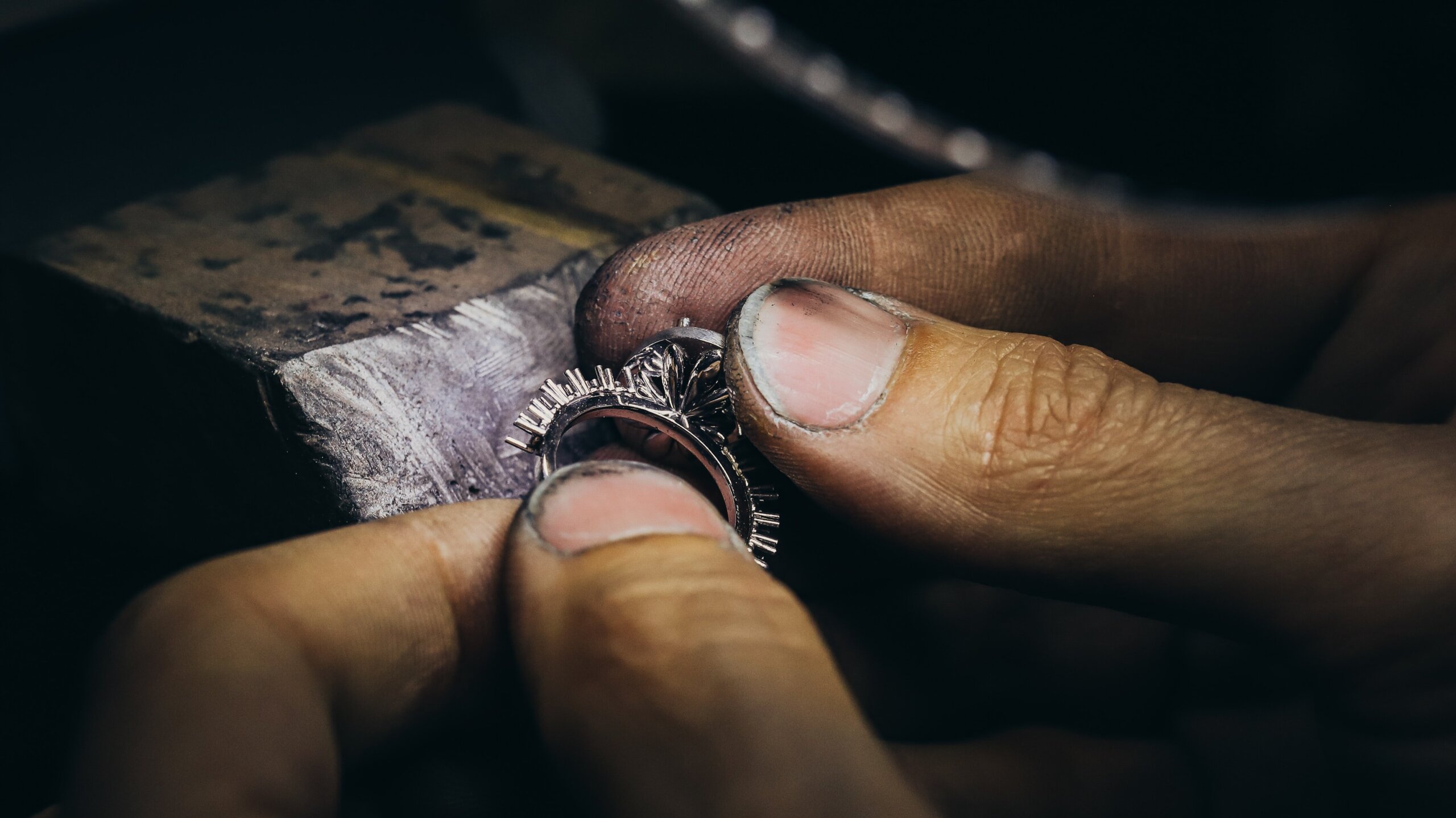
Resizing a Pavé Diamond Ring
This setting can make it much more complicated to change the size of the band, although it does depend on how much of the shank features these small diamonds.
Resizing a ring is always a complicated business. It’s much easier to say, ‘I’ll have it put down a size,’ than it is for a jeweler to work out how to alter the size of the shank without interrupting any of those intricate details or shapes.
A full pavé – that is, one that covers the entire shank – will be incredibly difficult to resize since each diamond is placed uniformly along the shank and cannot be moved a single millimeter in either direction.
If the pavé only features on the shoulders (upper half) of the ring, then the jeweler has more space to stretch or remove a segment of the ring. Still, a process like this is far from simple, and may still require a jeweler to spend a lot of time ensuring that none of the ring’s decorative elements are disrupted by the change.
Our advice? Find a way to figure out her ring size as accurately as possible, depending on how much of a secret your ring shopping is. Ask a friend, sister, or mom – check her jewelry box – or whip out the tape measure while she’s napping.
Pavé Setting Versatility: Combining it with the Cathedral Setting
A combination of the arched, cathedral shape rising above the shank, and completed with a pavé setting for added sparkle can be very striking.
One of the most important things to know about the pavé setting is quite how versatile it is. Whether you wish to use it with a cathedral setting, on a split or twisted shank, or on either side of a three stone engagement ring setting, it’s beautiful though understated look will harmonize with the center setting – and the rest of the ring’s design – without looking like ‘too much’.
Metal Choices: Platinum or Gold?
It comes down to personal preference. Platinum is tricky to work with and, as a result, more expensive, but the results are truly striking and worth the added investment.
Platinum is a strong metal, and working it into the incredibly precise and minute shapes the jeweler needs to achieve when creating a pavé setting is no mean feat. It takes a lot of work to get it right, particularly because of the fact it needs to be perfect the first time round, as platinum is no good for jewelry after being re-melted.
Don’t let that frighten you off, however; a good jeweler knows what to do. Besides, no other precious metal can rival platinum’s luminescent, white sheen – something which will make your pavé diamonds look as bright as stars when they are finally placed upon your bride-to-be’s finger.
Even so, the incredible contrast created between clear pavé diamonds and a warm toned band, like this rose gold halo cut engagement ring, is not an option that any shopper should be quick to cast aside.
A gold band, whether yellow, rose, or white, will also work out a little cheaper than platinum, but you can’t be sure where your preference lies until you see these metals in person – and, of course, how they interact with diamond.
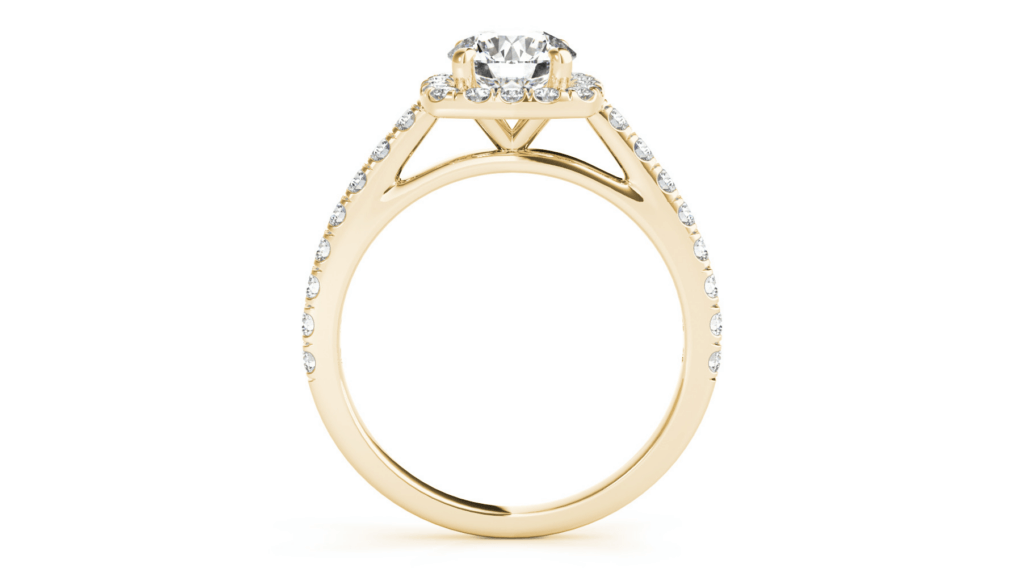
Pavé Wedding Bands
One of the most effective ways of making a wedding band look more special – or as part of a cohesive set with the engagement ring – is to use a pavé setting.
You might choose to mirror the pavé band in both your engagement ring and your wedding band, or to keep the shank of your engagement ring plain, and complement its center stone with a more intricated wedding band decorated with tiny pavé diamonds.
Again, you could pick either a full or half-pavé, keeping in mind the difficulty involved in resizing a full pavé band.
Our Expert Take
Out of all the design elements you can choose from as you begin designing your engagement ring, pavé is one of the most beautiful, most versatile, and most popular styles out there.
There is something very beautiful about a simple, plain band that lets the center diamond do all the talking but, at the same time, echoing that diamond’s incredible sparkle within the twinkling light of a pavé band is the ultimate way to bring any ring design to the next level.
As always, our best advice is to take a look for yourself. There’s no easy way of describing the magical way these tiny pavé diamonds explode with brilliance and fire when they are worn on the finger, and we defy anyone to make up their mind before they’ve seen it for themselves.
10 FAQs
- Q: What Are Pavé Diamonds?
- A: Pavé diamonds are small diamonds set closely together, typically along the band of a ring, to create a continuous sparkling effect. They are usually held in place by tiny beads or prongs.
- Q: Do Pavé Diamonds Fall Out Easily?
- A: Pavé diamonds are generally secure, but like any fine jewelry, they require proper care. If a pavé diamond is set correctly by a skilled jeweler, the risk of falling out is minimal. Regular check-ups with a jeweler are recommended.
- Q: What Does Pavé Mean for Rings?
- A: Pavé (pronounced “pah-vay”) is a French term meaning “paved.” In jewelry, it refers to the setting style where small diamonds are set close together to “pave” the ring, resembling a cobblestone street.
- Q: Are Pavé Diamonds Real?
- A: Yes, pavé diamonds are real diamonds. They are simply smaller in size compared to center stones in engagement rings.
- Q: Can You Resize a Pavé Diamond Ring?
- A: Resizing a pavé diamond ring can be challenging, especially if the pavé diamonds encircle the entire band. It’s easier to resize rings with pavé diamonds only on the top half of the band.
- Q: How Should You Clean Pavé Diamond Rings?
- A: Pavé diamond rings should be cleaned gently using warm soapy water and a soft brush. Avoid harsh chemicals and scrubbing. It’s also advisable to have professional cleanings periodically.
- Q: What Is the Difference Between Pavé and French Pavé?
- A: The main difference lies in the setting style. In French pavé, diamonds are set in a manner where a small V-shaped cut is made in the metal to expose the sides of the diamonds, enhancing their sparkle. Regular pavé settings may not have this feature.
- Q: How to Choose Between Micro Pavé and Regular Pavé?
- A: Micro pavé uses smaller diamonds compared to regular pavé. The choice depends on personal preference for the ring’s appearance; micro pavé offers a more delicate and detailed look.
- Q: What Metals Work Best with Pavé Diamonds?
- A: Platinum and white gold are popular choices as they provide a strong setting and enhance the brilliance of pavé diamonds. Yellow and rose gold are also options for a contrasting, warm effect.
- Q: Can Pavé Diamonds Enhance the Look of the Center Stone?
- A: Yes, pavé diamonds can enhance the overall brilliance of an engagement ring and make the center stone appear larger and more prominent due to the added sparkle.
Craft your dream pavé diamond engagement ring with Jeweler AI. Experience personalized elegance at your fingertips!
FOLLOW-UP GUIDE SERIES





